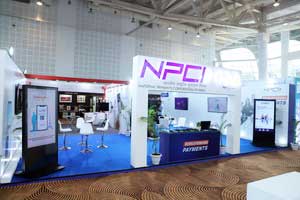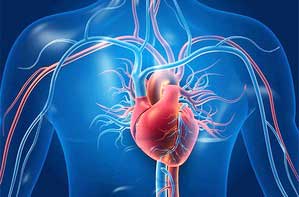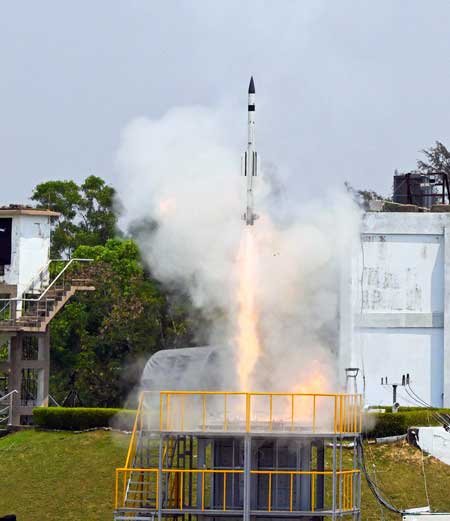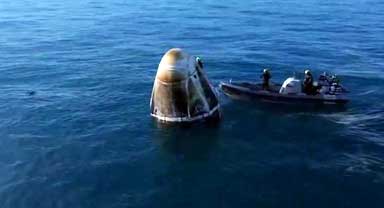India on Sunday moved a step ahead in getting its own reusable launch vehicle or reusable rocket (simply put similar to space shuttle) with the country's space agency successfully completing the Reusable Launch Vehicle Autonomous Landing Mission (RLV LEX).
The test was conducted at the Aeronautical Test Range (ATR), Chitradurga, Karnataka in the early hours on April 2, 2023.
The Indian space agency said the adaptation of contemporary technologies developed for RLV LEX makes other operational rockets more cost-effective.
In a first in the world, a winged body has been carried to an altitude of 4.5 km by a helicopter and released for carrying out an autonomous landing on a runway.
According to Indian Space Research Organisation (ISRO), the RLV took off at 7:10 a.m. IST by a Chinook Helicopter of the Indian Air Force as an underslung load and flew to a height of 4.5 km (above the mean seal level-MSL).
Once the predetermined pillbox parameters were attained, based on the RLV's Mission Management Computer command, the RLV was released in mid-air, at a down range of 4.6 km.
The Indian space agency said the release conditions included 10 parameters covering position, velocity, altitude and body rates and others.
The release of RLV was autonomous. RLV then performed approach and landing maneuvers using the integrated navigation, guidance & control system and completed an autonomous landing on the ATR air strip at 7:40 a.m. IST. With that, ISRO successfully achieved the autonomous landing of a space vehicle.
The autonomous landing was carried out under the exact conditions of a Space Re-entry vehicle's landing - high speed, unmanned, precise landing from the same return path - as if the vehicle arrives from space. Landing parameters such as ground relative velocity, the sink rate of landing gears, and precise body rates, as might be experienced by an orbital re-entry space vehicle in its return path, were achieved, ISRO said.
The RLV LEX demanded several state-of-the-art technologies including accurate navigation hardware and software, pseudolite system, Ka-band Radar Altimeter, NavIC receiver, indigenous landing gear, aerofoil honey-comb fins and brake parachute system.
RLV is essentially a space plane with a low lift to drag ratio requiring an approach at high glide angles that necessitated a landing at high velocities of 350 kmph.
According to ISRO, the LEX had used several indigenous systems like the navigation systems based on pseudolite systems, instrumentation, and sensor systems and others developed by it.
Digital Elevation Model (DEM) of the landing site with a Ka-band Radar Altimeter provided accurate altitude information.
Extensive wind tunnel tests and computational fluid dynamics (CFD) simulations enabled aerodynamic characterisation of RLV prior to the flight.
ISRO had demonstrated the re-entry of its winged vehicle RLV-TD in the HEX mission in May 2016. The re-entry of a hypersonic sub-orbital vehicle marked a major accomplishment in developing reusable rockets.
In HEX, the vehicle landed on a hypothetical runway over the Bay of Bengal. Precise landing on a runway was an aspect not included in the HEX mission.
On Sunday, the LEX mission achieved the final approach phase that coincided with the re-entry return flight path exhibiting an autonomous, high speed (350 kmph) landing. The LEX began with an Integrated Navigation test in 2019 and followed multiple Engineering Model Trials and Captive Phase tests in subsequent years.






NPCI to decide on person-to-merchant payments cap on UPI transactions: RBI
In order to further boost digital payments, the National Payments Corporation of India will be enabled to set the limit on person-to-merchants transactions via Unified Payments Interface (UPI), RBI Governor Sanjay Malhotra said on Wednesday.
New AI algorithm to predict risk of cardiovascular events, heart-related death
A team of researchers in South Korea has developed a novel artificial intelligence (AI)-based algorithm that uses electrocardiograph (ECG)2 data to predict the risk of cardiovascular events, and heart-related death.
India successfully flight-tests indigenously-developed vertically-launched Surface-to-Air Missile
In a boost to India's precision firepower, the Defence Research & Development Organisation (DRDO) and the Indian Navy conducted the successful flight-test of indigenously-developed Vertically-Launched Short-Range Surface-to-Air Missile (VLSRSAM) on Wednesday, an official statement said.
Unplanned welcome: Dolphins greet astronauts as they return home after extended space mission
Astronauts Sunita Williams and Butch Wilmore, along with NASA’s Nick Hague and Russian cosmonaut Aleksandr Gorbunov, have returned to Earth after a lengthy journey that turned a planned eight-day mission into a nine-month in space.
Stranded US astronauts return to Earth, after nine months in space
The SpaceX Dragon spacecraft carrying them and two other astronauts—Nick Hague and Russian cosmonaut Aleksandr Gorbunov—splashed down into the waters off the coast of Florida state just minutes before 6 p.m., as NASA had announced.
Google to acquire cloud security platform Wiz for $32 billion
Tech major Google on Tuesday announced to acquire Wiz, a leading cloud security platform headquartered in New York, for $32 billion in an all-cash transaction.
Ahead of Sunita William’s ‘homecoming’, PM Modi pens letter to India’s illustrious daughter
As the NASA astronauts Sunita Williams and Butch Wilmore begin their journey back home from space, after staying ‘stranded’ at the International Space Station (ISS) for about nine months, Prime Minister Narendra Modi has written a letter to one of India’s most illustrious daughters hoping for her safe return.
Sunita Williams set to return to Earth tomorrow
With the pair of US astronauts stranded for more than nine months on the International Space Station (ISS), the National Aeronautics and Space Administration (NASA) has confirmed that the duo will return to Earth on Tuesday evening.